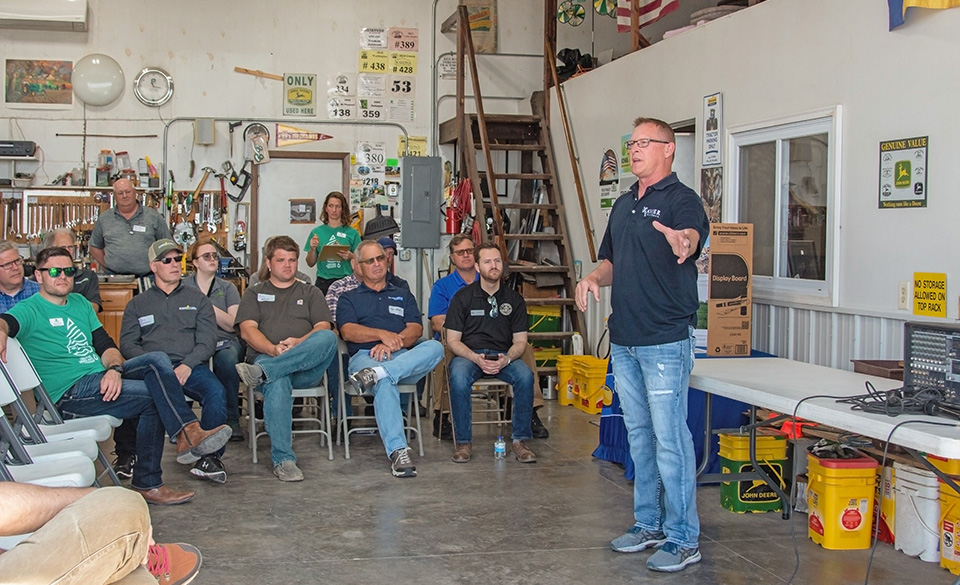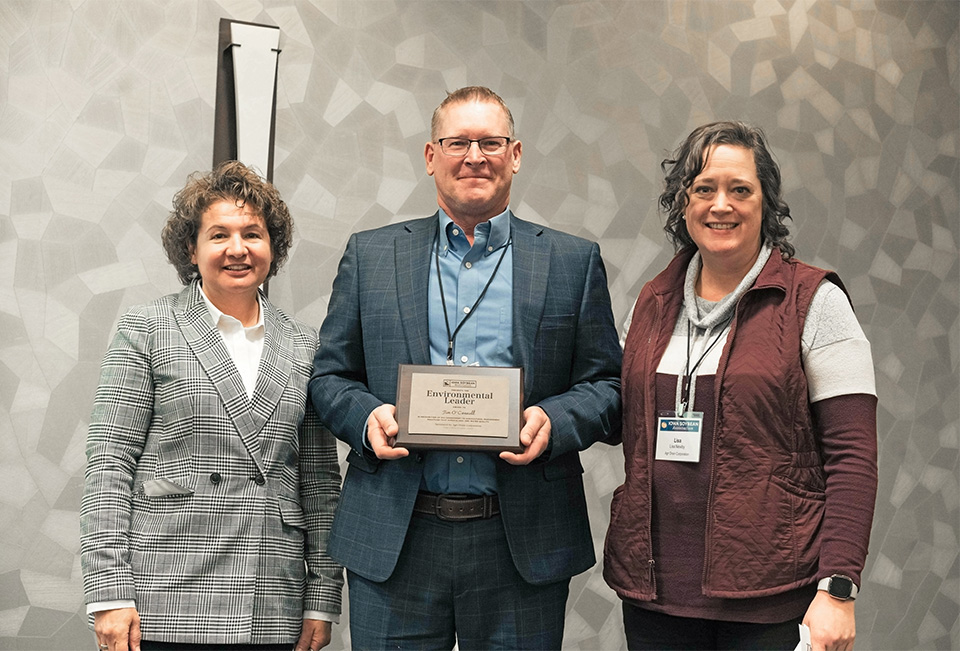
(Photo: Iowa Agriculture Water Alliance / Rebekah Jones)
Leading the way in conservation
March 11, 2024
Jim O’Connell leads and inspires Iowa farmers.
“Do you want your children to be able to farm?” asks Linn County farmer and Iowa Soybean Association (ISA) member Jim O’Connell. “If we don’t start doing things to help the environment, your sons or daughters may not have that opportunity.”
That viewpoint, along with years of integrating sustainable and environmentally-sound practices on his farm, is the reason O’Connell was recently presented with ISA’s 2024 Environmental Leader Award.
The work continues
Through his work with ISA’s Research Center for Farming Innovation, O’Connell has implemented unique strategies to improve soil health and enhance water quality.
He is an advocate and leader when it comes to the Iowa Nutrient Reduction Strategy (NRS), protecting against soil erosion and improving water quality while simultaneously bettering yields and bolstering his bottom line. He has been instrumental in the NRS by making changes to his farm.
Those practices have positively impacted the Cedar River Watershed. His work, along with other farmers in the area, is part of the Cedar River Source Water Partnership, designed to help protect water resources for the city of Cedar Rapids. He recently developed a wetland on his land to improve water quality.
“It not only helps me, but it helps everyone,” he says. “I want clean water, too.”
Wetlands, cover crops, bioreactors, saturated buffers and other edge-of-field practices are critical, O’Connell says.
While recognizing the challenges that come with transitioning from traditional farming to implementing conservation practices in his fields, O’Connell says these changes are imperative. “We need to break the cycle and say that it’s OK to no-till, strip-till and not work the ground up,” he says. “We need to change hearts and minds. Many farmers are intimidated by conservation because they don’t know where to start.”
Conservation practices are very much a leap into the unknown, but O’Connell says it’s a process that must be undertaken.
“We’re still learning,” he says. “It’s trial and error every year. It’s about taking baby steps.”
O’Connell’s foray into many of the conservation practices began more than a decade ago, first starting out with a few acres devoted to the use of cover crops.
He acknowledges the results and efforts may not yield the kind of results a farmer wants right away.
“People want instant gratification, but it takes time to see the results,” O’Connell says. “It’s not going to happen overnight.”
He says less chemical use, less soil erosion but strong, resilient yields are the results of years of conservation practices.
O’Connell says the work he has done in the fields does take time — something he says others have said to him they don’t have enough of.
“That’s the hard part and the challenge that we’re facing,” he says. “I’ve been doing this for 12 years. You’ve got to be willing to do the extra things to make it work.”

Making the time
He dismisses any notions that there isn’t enough time to initiate conservation practices that will have an impact in the fields.
When harvest is in full swing, O’Connell also coaches high school football at Cedar Rapids Xavier where he is the defensive coordinator. It’s more than a full schedule, but one that is worth the effort.
“Don’t tell me you don’t have time,” he says. “I don’t have help and I have 1,000 acres (of corn and soybeans), as well as a cattle operation. Don’t tell me that time is your problem.”
Praise from others
O’Connell’s conservation efforts are well known to those who know him, including his neighbor, Dan Voss.
Voss says O’Connell is more than worthy of the ISA Environmental Leader Award.
“I’m glad to see Jim receive this award,” he says. “He has always been forward thinking on conservation on the farm. I’ve leaned on him for some ideas on cover crops.”
Voss, who also has been recognized for his conservation practices, says he and O’Connell are showing others that cover crops, bioreactors, establishing wetlands and other practices are the future.
“If farmers are actually tilling in our area, they’re an outlier. No-till and strip-till are accepted practices around here.” Voss says. “How Jim does things is really making a difference.
“I’ve known him for many years and he’s very deserving of the accolades. He’s a shining example of how to continue these conservation practices. The public needs to know what he’s doing because conservation is not just an ag issue, it’s a societal issue.”
ISA Conservation Agronomist Evan Brehm agrees.
“Jim exemplifies what it means to be a good steward of the land,” says Brehm. “He finds a way to make it work profitably on his farm, but also what it takes to make the community and society better.”
Brehm says O’Connell’s recognition sends the right message to those in agriculture that you can help the environment while still protecting one’s bottom line.
“I’ve known Jim for years and have worked with him on edge-of-field practices, inputs, cover crops … he is deserving of this award.”
Leaving ‘a better product’
O’Connell says he is humbled and honored with the award and says his work will continue because it’s important for his farm, society and those who value clean water and a strong environment.
“I remember planting cover crops during one of those first years,” he says. “We had a 6-inch rain, and I noticed the waterway wasn’t cloudy or dirty. I have to believe the cover crops helped. I also had some of the best yields ever.
“The ground is given to us to care for and maintain,” O’Connell says. “I learned from my dad that if you use somebody else’s equipment, you better return it in better shape from when you borrowed it. I look at the ground the same way. I want my son to have a better product when he starts to farm.”
Back